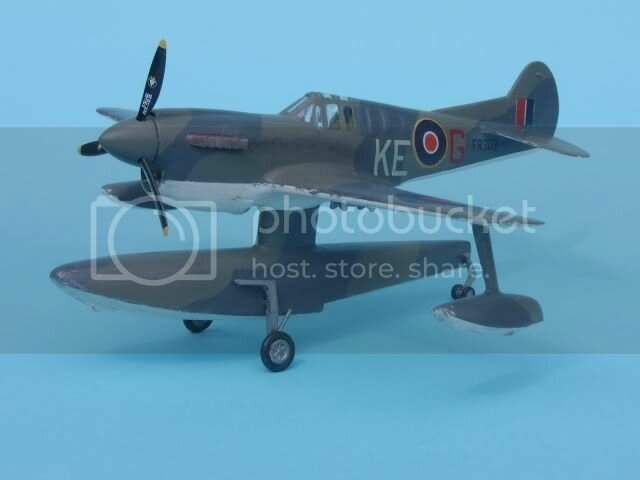I also found the text to go with the photos. I could not locate the origin or the author.
"SPITFIRE FLOATPLANE
Having been originally developed from the Supermarine S6B it is perhaps natural that the Spitfire should be developed for use on water.
The first Spitfire floatplane was a conversion of a Mark I, the so called "Narvik Nightmare" R6722 which was produced at the time of the German invasion of Norway where there emerged a requirement for a fighter capable of flying from the Fjords in view of the lack of suitable airfields in the country.
In the interests of speed, floats from a Blackburn Roc were fitted but the trials were not successful and as the campaign for which the conversion was required was rapidly drawing to a close the project was suspended.
The idea was revived again with the beginning of the war in the Pacific against Japan when it was realized that a floatplane fighter with good performance would be an essential asset in the island campaigns which seemed likely.
Folland Aircraft undertook the conversion of a Spitfire Mk Vb, W3760, with Supermarine designed floats and this aircraft proved an immediate success with a top speed of 324 mph. In this aircraft the carburetor air intake was extended to avoid spray, a shorter four blade propeller was fitted, cantilever pylons attached the floats to the inboard wing sections, a ventral fin replaced the tail wheel and the fin was extended slightly forward to increase the vertical tail surface area.
Mark V conversion (Original Fin)
Folland built several sets of floats and converted another two Mark V aircraft, EP751 and EP754. These together with W3760 were shipped to Egypt in 1943 and assembled with the intention of covertly operating them out of small Greek islands to intercept German transport aircraft. (Note original fin and added sub fin.)
Spitfire Floatplane EP751 - photograph taken in the Middle East and kindly provided by Terry Cheeseman - his Father, E P Cheeseman is sitting on the far left. (Extended Fin)
Spitfire Floatplane MkIX - MJ892 (Note fin change)
SUPERMARINE SPITFIRE FLOATPLANE
A further Spitfire was converted in 1944, a Mark IX serial MJ892 powered by a Merlin 45. The performance of this aircraft was superb and with a top speed of 377 mph the fastest floatplane of the entire war.
SUPERMARINE SPITFIRE FLOATPLANE - Floatplane fighter version of Supermarine Spitfire initiated during 1942, based on Mk VB airframe using floats designed by Supermarine (as Supermarine Type 355). Conversion by Folland Aircraft, with four-bladed propeller on Merlin 45 engines, tropical filter and extra ventral fin. First flown October 12, 1942, and later fitted with extra dorsal fin and Aero-Vee tropical filter. Two further Mk VB conversions by Folland during 1943; all three to Egypt late-1943 and flown from Great Bitter Lake, but no operational use. One Supermarine Spitfire LF Mk IXB, with Merlin 66 and four-bladed propeller (Type 385), similarly converted by Folland, first flown June 18, 1944, later reconverted to land-plane.
Data for Mk VB floatplane: Max speed, 324 mph (521 km/h) at 19,500ft (5,944 m). Initial climb, 2,240 ft/min (11.38 m/sec). Service ceiling (estimated), 33,400 ft (10,180 m). Empty weight, 6,014 Ib (2,728 kg). Gross weight, 7,580 Ib (3,438 kg). Span, 36ft 0 in (11.23 m). Length, 35ft 4 in (10.76m)."




